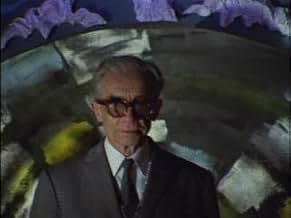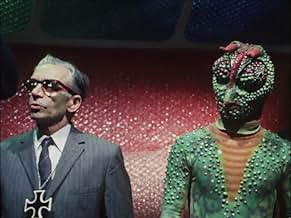Un cyborg ressemblant à une sauterelle et pilotant une moto (rejoint par un autre cyborg plus tard dans la série) combat l'organisation maléfique qui l'a transformé pour commettre ses méfait... Tout lireUn cyborg ressemblant à une sauterelle et pilotant une moto (rejoint par un autre cyborg plus tard dans la série) combat l'organisation maléfique qui l'a transformé pour commettre ses méfaits.Un cyborg ressemblant à une sauterelle et pilotant une moto (rejoint par un autre cyborg plus tard dans la série) combat l'organisation maléfique qui l'a transformé pour commettre ses méfaits.
Parcourir les épisodes
Avis à la une
I've just seen an episode of Kamen Rider, and i've never seen a Superhero so dark, with such cool and dark villans. For a show made in the 70's,it can still attract newcomers. I think the only american superheroes that can come close to the darkness that is Kamen Rider are Batman, Spawn and Blade. I give this show a 10
The first 13 episodes with Hongo are genuinely incredible. Those episodes are dark, and though aged and campy, have great villains and character development.
Rider 2 though enjoyable, lacks the tone and charm of the original. His episodes are best when Hongo crosses over.
The first 13 episodes are the franchise high in my opinion, but the rest of the series still has a lot to offer. Check it out and just fall into the Kamen Rider rabbit hole.
Rider 2 though enjoyable, lacks the tone and charm of the original. His episodes are best when Hongo crosses over.
The first 13 episodes are the franchise high in my opinion, but the rest of the series still has a lot to offer. Check it out and just fall into the Kamen Rider rabbit hole.
The first Kamen Rider series, titled "Kamen Rider" is what every american superhero series should be like. It's dark, it's action packed, it has a gloomy atmosphere. All the Kamen Rider movies and shows are like that, but this series went under fire for the excessive violence. This show is great, Hiroshi Fujioka and the rest of the cast do a great job in this 98-episode saga against Shocker, and Gel-Shocker. The action is great, but gets better as the show progresses. Hiroshi Fujioka did most of his own stunts in and out of costume, but got into a stunt accident early in the show, and left for a while. So they brought in a couple new characters, Special Agent Taki, and the next Kamen Rider, Kamen Rider 2!
Unfortunately, being a newbie of this franchise I though that starting with its first series ever it would have proven the right choice since usually by doing that I've found a lots of gems people tend to not consider because of their age, in both the comic medium and the anime one. This is not one of those gems, except the first 10/13 episodes that are interesting because they show you how originally the series was intended to be, I. E. akin to the american golden age of comics with lots of blood and dismemberment (something I'm not particularly fond when it's done past that specific period except when it has a meaning behind and it's not just for gore's sake). After that, what you're going to see if you stick until the end (something I don't recommend doing) is a progressively kiddified affair that is really, really and I can't stress enough REALLY repetitive and way more repetitive, boring and hamfisted than a lot of classic 100+ or 200+ episodes repetitive animes I've seen from front to end (fillers and recaps included) without being bored once with nothing particularly engaging if we exclude the occasional campy glimpse (provided you're a sucker of camp like me), the nice eye-candy chicks who start by factually fighting the minions and end being treated like nothing more than props and a couple of interesting episodes, in particular episode 84 which is the way I personally like superheroes to be. Other than that there is nothing here for newcomers, so as a newcomer to this franchise myself I can't recommend this to anyone in my situation. Go down on other series of the franchise before this, not on this one.
Rarely was there ever such a hero as Shoutarou Ishinomori's MASKED RIDER in the tokusatsu field before that time. Manga/anime characters such as Kazumasa Hirai/Jirou Kuwata's EIGHT-MAN (the granddaddy of the genre) and Ishinomori's own CYBORG 009 were similar to MASKED RIDER, but the more popular superheroes in tokusatsu was ULTRAMAN, its sequels (notably ULTRA SEVEN) and imitations. Toei producer Tooru Hirayama, attempted to bring back the Masked Superhero genre, but their drafts were unsuccessful, until Ishinomori published a 100-page one-shot comic-book story called SKULLMAN in early 1971. Though the character of Skullman was more of an antihero than his resulting TV counterpart, the comic was successful enough for Hirayama to request changes from Ishinomori, turning Skullman into a grasshopper variant (a design chosen by his then five-year old son Jou) called "Masked Rider Hopper King," which was shortened to just "Masked Rider," and the rest was history!
The show concerns a runaway cyborg grashopper-man who sets out to avenge the death of his teacher and the loss of his humanity (he is, in reality, scientist/motorcycle racer Takeshi Hongou) by fighting the evil forces of Shocker, the Nazi-like organization that transformed him in the first place (he was meant to be the perfect weapon against society). As the "Masked Rider," Takeshi Hongou rides the super motorcycle Cyclone, and with super-speed and super-strength, performs high-flying rechniques such as the Rider-Jump to reach the top of buildings, or his killing technique, the Rider-Kick!
The show began as dark, serious and violent, but many complications (including star Hiroshi Fujioka temporarily leaving the series due to a stunt-related accident) forced the series to change into the more kid-friendly and somewhat comical series that everyone's more accustomed to. However, it's still a fun, action-packed series with plenty of monsters and henchmen that Masked Rider and Masked Rider 2 (a similar Masked Rider, Hayato Ichimonji, played by Takeshi Sasaki, took over from the fallen Fujioka as star for a time) fight each week!
The series ran for 98 episodes, and would be impossible to do a detailed review here, suffice to say that I thought the less-complicated sequel series MASKED RIDER V3 (1973) was even better than the original! Still, MASKED RIDER was the one that started it all for morphing superheroes (or "henshin" heroes) as we all know, and is the most important show in this genre! I highly reccommend the early episodes, from 1-13, but the rest is still fun and action-packed to watch! HIGHLY RECCOMMENDED!!!
The show concerns a runaway cyborg grashopper-man who sets out to avenge the death of his teacher and the loss of his humanity (he is, in reality, scientist/motorcycle racer Takeshi Hongou) by fighting the evil forces of Shocker, the Nazi-like organization that transformed him in the first place (he was meant to be the perfect weapon against society). As the "Masked Rider," Takeshi Hongou rides the super motorcycle Cyclone, and with super-speed and super-strength, performs high-flying rechniques such as the Rider-Jump to reach the top of buildings, or his killing technique, the Rider-Kick!
The show began as dark, serious and violent, but many complications (including star Hiroshi Fujioka temporarily leaving the series due to a stunt-related accident) forced the series to change into the more kid-friendly and somewhat comical series that everyone's more accustomed to. However, it's still a fun, action-packed series with plenty of monsters and henchmen that Masked Rider and Masked Rider 2 (a similar Masked Rider, Hayato Ichimonji, played by Takeshi Sasaki, took over from the fallen Fujioka as star for a time) fight each week!
The series ran for 98 episodes, and would be impossible to do a detailed review here, suffice to say that I thought the less-complicated sequel series MASKED RIDER V3 (1973) was even better than the original! Still, MASKED RIDER was the one that started it all for morphing superheroes (or "henshin" heroes) as we all know, and is the most important show in this genre! I highly reccommend the early episodes, from 1-13, but the rest is still fun and action-packed to watch! HIGHLY RECCOMMENDED!!!
Le saviez-vous
- AnecdotesAs with Urutoraman: Kûsô tokusatsu shirîzu (1966), this series, created by manga artist Shotaro Ishinomori, gave birth to another popular type of modern Japanese superhero: The "Henshin" (Japanese for "transformation") Hero. These are normal-sized superheroes who transform into a cyborg, android or mutant by performing a "henshin pose," and usually fight their enemies with martial arts, minimal weaponry and a finishing attack (usually a flying kick). The Sentai Series (starting with Ishinomori's Himitsu sentai Gorenjâ (1975)), Metal Heroes (starting with X-OR (1982)) and hundreds of other contemporary Japanese superheroes were an offshoot of this historically-important genre.
- Citations
Takeshi Hongô: [his "henshin" phrase] Rider... Henshin!
- ConnexionsFeatured in The Toys That Made Us: Mighty Morphin Power Rangers (2019)
- Bandes originalesRettsu Gô!! Raidâ Kikku
(Let's Go!! Rider Kick)
Performed by Hiroshi Fujioka and Male Harmony (episodes #1-13), Masato Shimon (as Kôichi Fuji) and Male Harmony (episodes #14-88)
Lyrics by Shotaro Ishinomori
Music and arrangement by Shunsuke Kikuchi
(First opening theme episodes 1-88)
Meilleurs choix
Connectez-vous pour évaluer et suivre la liste de favoris afin de recevoir des recommandations personnalisées
- How many seasons does Kamen Rider have?Alimenté par Alexa
Détails
Contribuer à cette page
Suggérer une modification ou ajouter du contenu manquant

Lacune principale
By what name was Kamen Raidâ (1971) officially released in Canada in English?
Répondre























